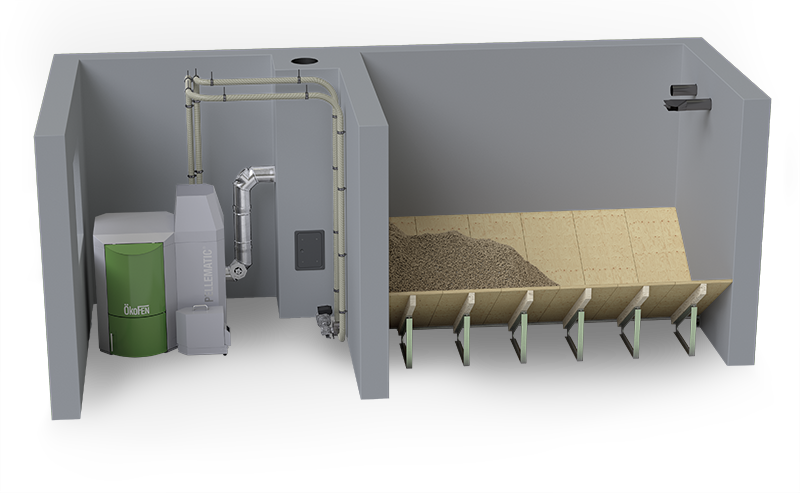Storage room
The optimal storage of the pellets depends on your spatial conditions.
This means we have unrivalled know-how and an unsurpassed range of solutions for adapting cellars and other rooms for pellet storage.
We can provide advice on every aspect of storage, from the correct amount of space for your system through to all-inclusive solutions with bespoke floor plans and automated pellet transport to the boiler.
Information and tips for the planning of pellet heating systems with storage room
Location of the wood pellet storage and the boiler room
Pellets are delivered by tanker truck and are blown into the storage room or the FlexiTank. The truck's pumping hose is max. 30 m length, so the filler coupling must be no more than 30m from the drive, parking space or road.
If possible, the FlexiTank room should border at least one exterior wall, since the filler coupling must be accessible from the outside. Where this is not possible, ventilation and filling pipes must be routed to a filler coupling on the outside of the building. (Attention - in some countries fire regulations must be observed).
The boiler room should also have at least one exterior wall in order to allow direct ventilation.
Size of the wood pellet storage and the boiler room
Basically, the wood pellet storage room should be elongated rectangular, with a room width - if possible - no more than 2.0 m:
i.e. W: 2 m x 3 m or 1,8 m x 3,2 m etc.
The narrower the room, the less unused empty space. The size of the required storage room depends on the building heat demand. The following rule of thumb may be applied:
per 1 kW heating load = 0,9 m³ Storage room (including unused empty space)
For example:
One family house with a heat load of 10 kW = 4.000 kg wood pellet annual requirement
Filler coupling with closing lid:
The pellets are blown directly into the storage room and the discharged air is evacuated. This requires two "filler couplings" with a lid. (1 x blow + 1 x evacuate)
These couplings including extension pipes, curve pieps and other accessories, are supplied by ÖkoFEN together with the heating system. A wall opening with a diameter of 125 to 150 mm must be prepared on site. It is recommended to use a PVC pipe with a diameter of 125 to 150 mm fixed to the brickwork. The filling couplings are then foamed in the prepared openings. The filler couplings must be connected to the brickwork (grounding).


 Menue
Menue

